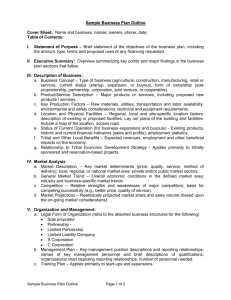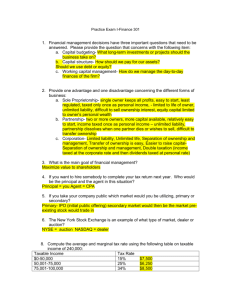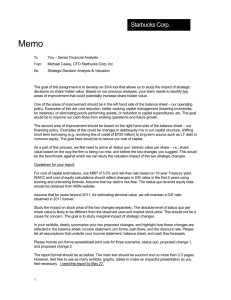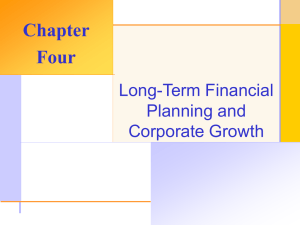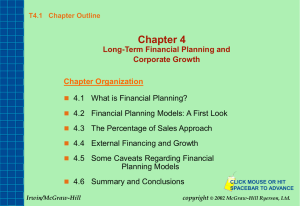sales growth
advertisement
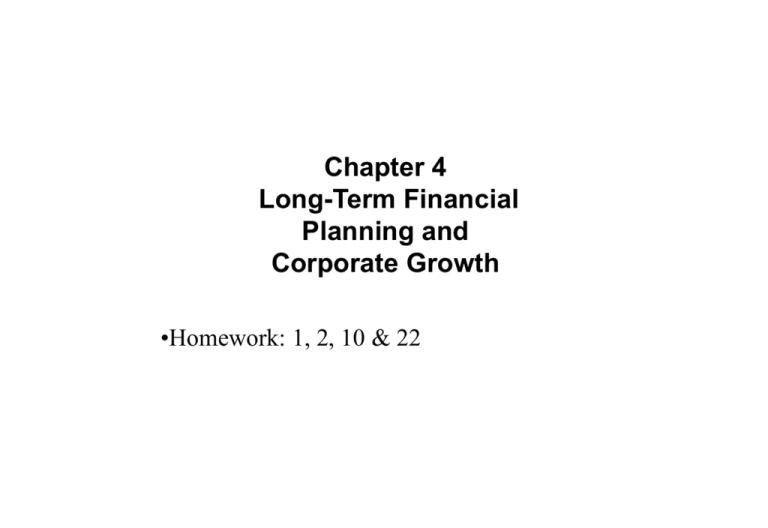
Chapter 4 Long-Term Financial Planning and Corporate Growth •Homework: 1, 2, 10 & 22 Lecture Organization What is Financial Planning? Financial Planning Models: A First Look The Percentage of Sales Approach External Financing and Growth Financial Planning Model Ingredients Sales Forecast Drives the model Pro Forma Statements The output summarizing different projections Asset Requirements Investment needed to support sales growth Financial Requirements Debt and dividend policies The “Plug” Designated source(s) of external financing Example: A Simple Financial Planning Model Recent Financial Statements Income statement Sales $100 Costs 90 Net Income $ 10 Balance sheet Assets Total $50 Debt $20 Equity 30 Total $50 $50 Assume that: 1. sales are projected to rise by 25% 2. the debt/equity ratio stays at 2/3 3. costs and assets grow at the same rate as sales Example: A Simple Financial Planning Model (concluded) Pro Forma Financial Statements Income statement Balance sheet Sales $______ Assets $______ Debt ______ Costs ______ ______ Equity ______ $ ______ Total $______ Net Total $______ The Percentage of Sales Approach: General Formulas Given a sales forecast and an estimated profit margin, what addition to retained earnings can be expected? Let: S = previous period’s sales g = projected increase in sales PM = profit margin b = earnings retention (“plowback”) ratio The expected addition to retained earnings is: S(1 + g) PM b This represents the level of internal financing the firm is expected to generate over the coming period. The Percentage of Sales Approach: General Formulas (concluded) What level of asset investment is needed to support a given level of sales growth? For simplicity, assume we are at full capacity. Then the indicated increase in assets required equals If the required increase in assets exceeds the internal funding available (i.e., the increase in retained earnings), then the difference is the The Percentage of Sales Approach Income Statement (projected growth = 30%) Original Sales $2000 Costs 1700 Pro forma $_____ (+30%) 2210 (= 85% of sales) EBT 300 _____ Taxes (34%) 102 132.6 Net income 198 257.4 Dividends 66 Add. to ret. Earnings____ 85.8 (= 1/3 of net) ____ (= 2/3 of net) The Percentage of Sales Approach (concluded) Preliminary Balance Sheet Orig. % of sales $100 ___% A/R 120 6% Inv 140 7% $360 __% 640 32% Cash Total NFA Total $1000 50% Orig. % of sales A/P $60 ___% N/P 140 n/a 200 n/a LTD $200 n/a C/S 10 n/a R/E 590 n/a $600 n/a $1000 n/a Total Total Pro Forma Statements The Percentage of Sales Approach, Continued Proj. Cash (+/-) Proj. (+/-) $____ $____ A/P $____ $____ A/R ____ ____ N/P ____ ____ Inv 182 42 $____ $____ $____ $108 LTD 200 832 192 C/S 10 R/E 761.6 ____ $771.6 $____ $1189.6 $____ Total NFA Total $____ Total $____ Total _ Growth and External Financing Key issue: What is the relationship between sales growth and financing needs? Recent Financial Statements Income statement Sales $100 Costs 90 Net $ 10 Balance sheet Assets $50 Debt Equity Total $50 Total $20 30 $50 Growth and External Financing (concluded) Assume that: 1. costs and assets grow at the same rate as sales 2. 60% of net income is paid out in dividends 3. no external financing is available (debt or equity) Q. What is the maximum growth rate achievable? A. The maximum growth rate is given by ROA Internal growth rate (IGR) = 1 - (ROA b b) Growth and Financing Needed for the Hoffman Company (Figure 4.1) Growth and Financing Needed for the Hoffman Company (Figure 4.1) The Internal Growth Rate Assume sales do grow at 8.7 percent. How are the financial statements affected? Pro Forma Financial Statements Income statement Sales $108.70 Costs 97.83 Net $10.87 Dividends $6.52 Add to R/E _____ Balance sheet Assets $54.35 Debt $20.00 Equity Total $54.35 _____ Total $_____ Internal Growth Rate (concluded) Now assume: 1. no external equity financing is available 2. the current debt/equity ratio is optimal Q. What is the maximum growth rate achievable now? A. The maximum growth rate is given by ROE Sustainable growth rate (SGR) = 1 - (ROE b b) The Sustainable Growth Rate Assume sales do grow at 15.385 percent: Pro Forma Financial Statements Income statement Sales $115.38 Costs 103.85 Net $11.53 Dividends Add to R/E $6.92 _____ Balance sheet Assets $57.69 Debt Equity Total $57.69 If we borrow the $3.08, the debt/equity ratio will be: $ _____/ _____=_____ $_____ _____ Total $_____ EFN $_____ Summary of Internal and Sustainable Growth Rates I. Internal Growth Rate IGR = (ROA b)/[1 - (ROA b)] where: ROA = return on assets = Net income/assets b = earnings retention or “plowback” ratio The IGR is the maximum growth rate that can be achieved with no external financing of any kind. II. Sustainable Growth Rate SGR = (ROE b)/[1 - (ROE b)] where: ROE = return on equity = Net income/equity b = earnings retention or “plowback” ratio The SGR is the maximum growth rate that can be achieved with no external equity financing while maintaining a constant debt/equity ratio. Chapter 4 Quick Quiz 1. How does one compute the external financing needed (EFN)? Why is this information important to a financial planner? 2. What is the internal growth rate (IGR)? 3. What is the sustainable growth rate (SGR)? 4. What kinds of questions might one ask in evaluating a financial plan? Solution to Problem 4.8 What is Ping, Li, Yi, & Co.’s maximum sales increase if no new equity is issued? Assume: Assets and costs are proportional to sales, 50% dividend payout ratio, and constant debt-equity ratio. Sales - Costs Taxable Income - Taxes $23,000 15,200 $ 7,800 2,652 Net Income $5,148 Net W. Cap. $10,500 Fixed Assets 50,000 $60,500 L. T. Debt Equity $30,000 30,500 $60,500 Solution to Problem 4.8 (concluded) SGR = (ROE b) / [1 - (ROE b)] ROE = = Net income / Equity $5,148 / $30,500 = .168787 b = = = Retention ratio 1 - Dividends/Net income 1 - .50 = .50 SGR = = (.168787 .0922 .50) / [1 - (.168788 .50)] Maximum Increase = Sales SGR = $23,000 .0922 = $2,120.60

